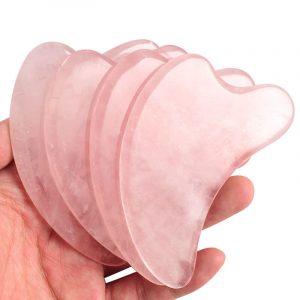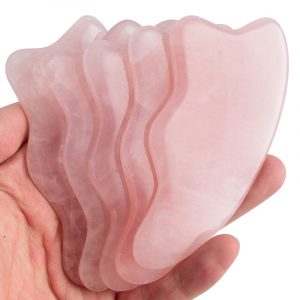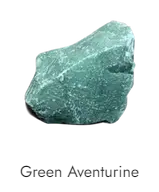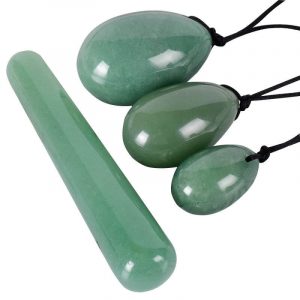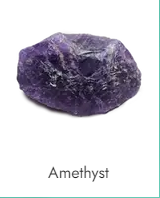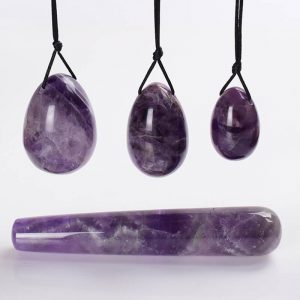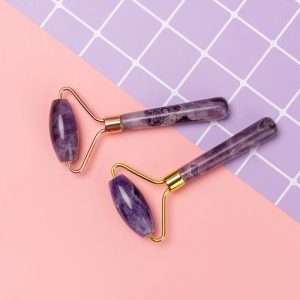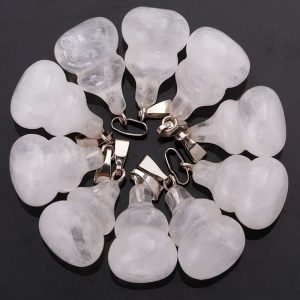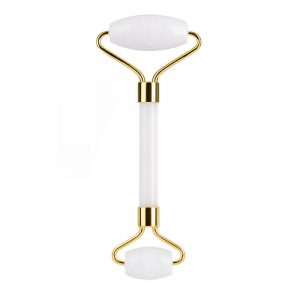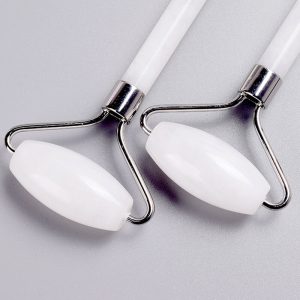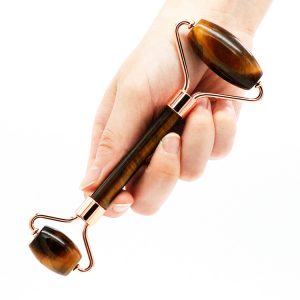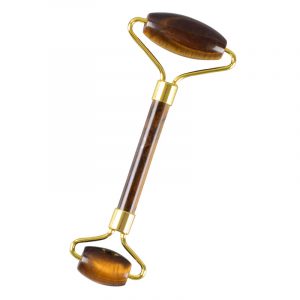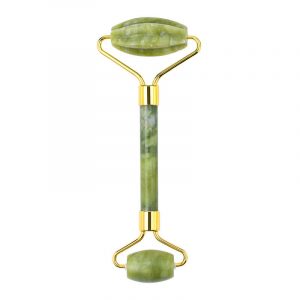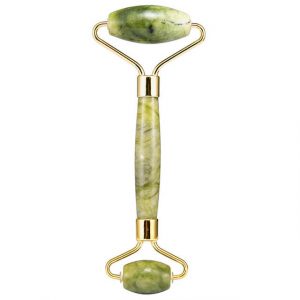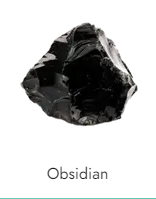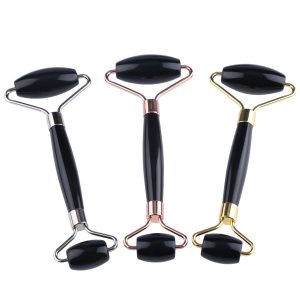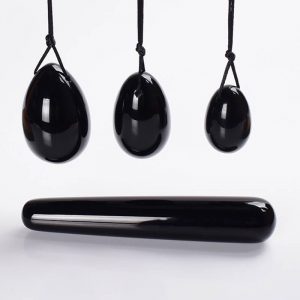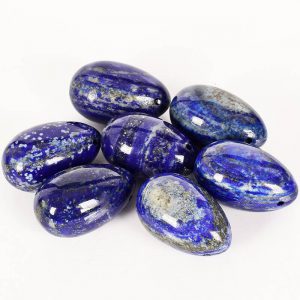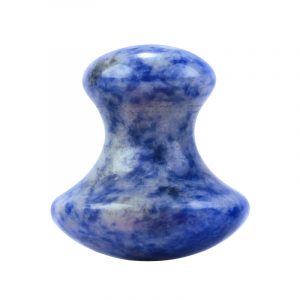Jade Stone Materials introduction for wholesale
Jade Stone Materials introduction for wholesale
Rose Quartz Stone
As we all know, our rose quartz roller are made of natural rose quartz stones. Rose quartz stone can be called pink crystal, rose crystal, hibiscus. This pink color may be caused by the titanium content.
Texture identification:
The high-quality stone requires its pink to be as deep as possible, transparent, crack-free.

Origin:
The rose quartz stone is mainly produced in Brazil, and the main producing areas of China are in Xinjiang and Yunnan. However, the quality of rose quartz stone from Brazil and Sri Lanka is the best. The material of our rose quartz rollers mostly come from Brazil.
Allusion:
This is an ancient Chinese legend.It is said that rose quartz stone was a love token given by Emperor Li Longji to his favorite imperial concubine Yang Yuhuan, and because its texture is like tearing of ice cubes, people later named it with Yang Yuhuan ’s nickname -hibiscus, so it was also called It is “ice flower hibiscus jade”.
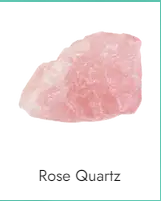
The color of rose stone is beautiful, and it symbolizes beautiful love, which is especially suitable for young people and people with white complexions. Hibiscus stone, also called love stone, is said to bring sweetness to couples.
Because the formation of rose quartz is located in the eye of the spring water, it is washed by the hot spring water, so there are many soluble minerals. It can sterilize and anti-inflammatory and whiten the skin.
Aventurine Stone
Main features:
Dongling jade, scientific name: aventurine, also known as ocean stone or Dongling stone, is called chromite-bearing mica quartzite in geology. Dongling stone is distributed in Yunnan, Guangxi, Guizhou, Beijing and Xinjiang of China. The largest output of Dongling stone is India, so it is also called “Indian Jade”. Dongling stone was also found in Spain, Russia, Brazil, Chile, and the United States. Dongling stone was originally colorless and pure white. In the long formation process, it contained other substances and trace elements, showing a series of attractive colors and special optical phenomena, and became a popular Dongling stone.
Efficacy:
Dongling stone is often used to relieve stress. Green Dongling stone is said to reduce anxiety and soothe emotions, and is best used for mood relief.
Classification:
Green Dongling jade; emerald green or dark green, distributed in silk like spots, the cause of green color is related to chromium-containing mica.
The first grade aventurine is bright green or dark green, with strong luster and translucency. The texture is dense, delicate, tough and smooth. Free of impurities, cracks and any other defects. The weight is over 6 kg.
The second grade aventurine is bright green, has a strong luster, and is slightly transparent. The texture is dense, delicate and tough. There are trace impurities or small spots, but no cracks and other defects. The weight is over 6 kg.
The third grade aventurine is green, with a strong luster of grease, and is slightly transparent. The texture is dense and tough. There are a few defects such as impurities and cracks.The weight is over 2 kg
Amethyst Stone
Amethyst is one of our company’s most expensive materials. Because of the special nature of this material, the amethyst roller is also a higher price product of our company.
Main features:
The main component of amethyst is silicon dioxide. Naturally produced amethyst forms a beautiful purple color because it contains minerals such as iron and manganese. Natural amethyst usually has natural ice cracks or white cloud impurities. Amethyst is produced in volcanic, pegmatite, or limestone or shale caves. Amethyst is mainly produced in Brazil, Russia, South Africa and Madagascar.
The Legend of Amethyst:
According to legend, Bacchus was angry because of a dispute with the goddess of the moon, Diana. So he sent fierce tigers to take revenge, but accidentally encountered Diana’s believer young girl Amethyst. In order to avoid the death of this young girl, Diana turned her into a flawless crystal statue.
Texture identification:
The natural amethyst crystal is transparent and has few cracks, but a clear color band can still be seen.
The temperature of natural amethyst will gradually increase with the body temperature, and finally it can maintain the same temperature as the human body. The synthetic amethyst is placed in the palm of the hand.
Although it may feel cold at the beginning, it will be higher than the body temperature after wearing it for a while. Amethyst, like other crystals, often contains cracks, tidbits or Inclusions of other minerals, but many bubbles will appear inside the synthetic amethyst crystal. Generally, the material of synthetic amethyst is glass, so if you don’t know the shape of the bubbles, you can look at the glass, you will find that the glass often contains bubbles.
maintenance:
Amethyst cannot be exposed to strong high temperature. In daily wear, you should be careful not to touch high temperature things, such as the heat of an electric oven,etc.
White Jade
White Jade is a kind of Nephrite Jade that is usually white,
off-white, or cream in color. This is Calcium Magnesium
Silicate Mineral.
White Jade is a gemstone that holds a lot of meaning and plenty of healing properties. It is believed that it has a positive and brilliant power of light that’s right within the stone. This stone is known for its power to make you feel calm and peaceful.
Its powerful healing energies are known all over the world because it has the ability to purify the energies of your heart. White Jade also has the ability to increase or enhance the energy of love in your life. It will make challenges seem easier, and it will make your troubled mind calmer.
White Jade can also bring richness, prosperity, and abundance in your life. Since the ancient times, this stone has been valued because of its abilities to bring luck in health, business, and love.
Wearing white jade jewelry is highly recommended if you want to benefit from the healing powers of this stone. Keeping the White jade close to you makes the mind calm. This stone will improve the body’s ability to defend and
protect itself. Doing so will also detoxify the blood and calm the verves so that you can fully relax.
It’s very beneficial to your heart in both the physical and spiritual sense. White Jade is also a very protective stone that will keep you out of harm’s way.
Tiger Eye Stone
Main features:
Tiger ’s eye is a kind of quartz aggregate, an irregular mineral. Its gemological name is Tiger eyes. Usually it has brownish yellow, blue, reddish brown and other colors, opaque, delicate and tough texture, with a fine fibrous structure.
Because of its shape and color like tiger eyes, it is named tiger’s eye stone. Among them, the lines are clear, bright, and complete, with good gloss and clear lines, like tiger eyes. There are no impurities on the stones, and the texture is uniform and the colors are best.
Origin:
The main place of origin is Africa, it is the national gem of South Africa. The world’s largest tiger eye stone is scattered in Africa and is located in the Transvaal Province of South Africa. In addition, India, Sri Lanka, Brazil, Namibia, Australia and Brazil all produced better tiger’s eye stones.
Xiuyan Stone
Main features:
Xiuyan jade is one of the four famous jade in the history of China (the others is Shaanxi Lantian jade, Xinjiang Hetian jade and Henan Dushan jade). Xiuyan is mainly produced in Liaoning Province, China. Xiuyan jade is tough, delicate, moist, bright, and rich in color.
It has six characteristics: large luster, beautiful chroma, high brightness, pure clarity, good density, and sufficient hardness.
Classification:
Accoding to the mineralogy, Xiuyan jade is divided into three categories: “Tremolite Jade”, “Serpentine Jade” and “Translucent-Serpentine Jade”. Serpentine jade is also a common jadeite jade.
Hight quality jade generally it is green, good transparency, no cracks.
The nephrite of tremolite is generally called old jade or fine jade. The texture of this jade is extremely delicate, tough and slightly transparent. Among them, the yellow and white old jade is the top grade. Due to its good quality and relatively small output, the price of tremolite jade is higher than that of serpentine jade.
The third type of jade is a combination of serpentine jade and tremolite jade. It is green and white, and is somewhat similar to jadeite jade. It started to be called “false jade”, but later felt that the fake word was not very good, and it gradually evolved into “emerald”.
Identification method
- Look at the color: The best color density is moderate, bright and beautiful, and evenly distributed.
- Look at transparency: Jade is generally opaque, translucent is more precious, and fully transparent Xiuyan jade has the best quality.
- Look at the texture: Xiuyan jade with good quality is naturally those with fine crystal grains, compact structure, less impurities, flaws and cracks. It can be observed through a magnifying glass or a microscope.
- Look at the clarity: the less impurities and flaws, the better the quality of Xiuyan jade
Obsidian Stone
Main features:
Obsidian is a common black gem, also known as “dragon crystal”. Most obsidian are produced in Central America and North America, and the national stone of Mexico is obsidian. Obsidian is also produced in China, such as in some parts of Tibet.
The Legend of Obsidian:
Obsidian: Alias, the Tears of Apache. In Indian legend, a team was ambushed by the enemy, outnumbered, and the whole army was wiped out. The bad news came, their family was in grief, their tears dropped to the ground and turned into small black stones, also known as gems that no longer crying.Thus, whoever owns this black gem, he will never crying agina, because the Apache girl has shed all him tears for he. You can send obsidian to someone you like, meaning no longer crying, blessing happiness.
Formation process:
Obsidian is a natural glass formed by the sudden cooling of magma flowing from volcanic lava. It belongs to amorphous gems and its main component is silicon dioxide (SiO2).
During the formation process, because the temperature around the lava flow drops rapidly and cools down the fastest, the silica-containing magma will quickly condense into blocks.
Obsidian is usually located near the lava flow or near the sea at the foot of the volcano appear.
Sodalite
Sodalite is a feldspathoidal tectosilicate mineral that is rich royal blue widely used as an ornamental gemstone. They sometimes fluoresce bright orange under ultraviolet light. Sodalite nearly always forms massive aggregates or disseminated grains.
Chemical Composition: Na4Al3Si3O12Cl Sodalite occurs in igneous rocks that crystallized from sodium-rich magmas. This is the origin of the name “Sodalite.” These magmas also contained so little silicon and aluminum that quartz and feldspar minerals are often absent. Sodalite-bearing rocks include Nepheline Syenite, Trachyte, and Phonolite.
Sodalite is usually blue to blue violet in color and found with nepheline and other feldspathoid minerals. Blue is a rare color for rocks and minerals. Sodalite is one of the only vivid blue materials that is still sold at a reasonable price. A limitation on sodalite’s use in jewelry is its hardness of 5.5 to 6 on the Mohs scale. For that reason, the stone is used as for the healing purposes and also for the crafted items.
Sodalite is originally discovered in Greenland in 1806. It gained notoriety in the 1800’s during a royal visit to Bancroft, Canada by Princess Margaret of England. For this reason, sodalite from that Canadian area is sometimes called Princess Blue.
The most important source of sodalite is Bancroft in Ontario, Canada. It is also found in Tasmania, Australia, India, Namibia, Columbia, the Eifel Mountains of Germany, the Ayopaya Province in Brazil, and the Kola Peninsula in Russia.

